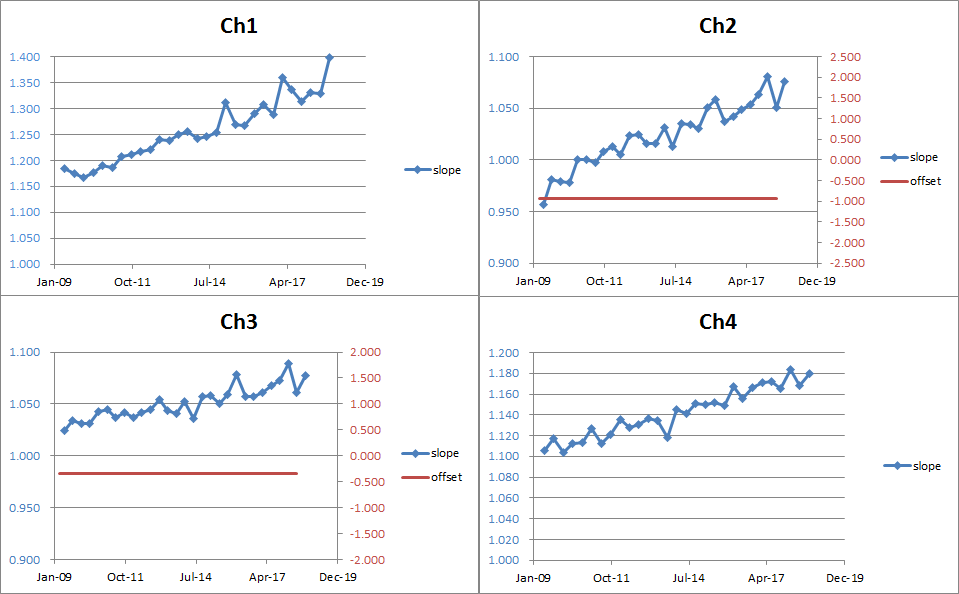Greenhouse gases Observing SATellite (GOSAT) mission
JAXA Supercomputer System Annual Report April 2018-March 2019
Report Number: R18ER2100
Subject Category: Space Technology
- Responsible Representative: Masakatsu Nakajima ,Space Technology Directorate I GOSAT-2 Project Team, Mission Manager
- Contact Information: Yoko Ueda(ueda.yoko@jaxa.jp)
- Members: Makiko Hashimoto, Kenji Kowata, Hideki Suetake, Makoto Imanaka, Akiko Otomo, Yoko Ueda, Tomoo Yamasaki, Hidetoshi Hayasaka, Mamoru Sugawara, Tomoyuki Mabuchi, Hideki Gabe, Takehito Yoshida, Fumie Kataoka, Shinpei Kondo, Masahito Arai
Abstract
GOSAT continues its observations beyond its 5-year mission, providing well-calibrated high spectral resolution data. The overall functions and performances are successful and no significant degradation of SNR and spectral resolution has been observed. Several anomalies were found onboard, but they have stabilized since. The Level 1 algorithms have been updated since launch in order to correct these anomalies.
Reference URL
Please refer to ‘HOME – GOSAT – JAXA‘.
Reasons for using JSS2
GOSAT mission utilizes JSS2 as one of the GOSAT Mission Operation System which processes the observation data of GOSAT. When processing algorithm is updated, JSS2 reprocesses all data observed in the past. When we calibrate products, JSS2 processes all data in the past. Also, JSS2 is used as a remote storage of all data required for its reprocessing.
Achievements of the Year
Calibration and validation of GOSAT TANSO-CAI data
On-orbit sensor sensitivity change is evaluated from TANSO-CAI observation data. We expect to determine the CAI Band 1 radiometric calibration factor (or formula) by calculation of radiative transfer model using in-situ and other satellite data. The CAI Band 1 has an important information of aerosol size distribution. Hence, Band 1 radiance is optimized to agree with calibrated radiances of Band 2 and Band 3. Calibration formula of Band 2 and Band 3 are obtained as three candidates. Thus, Band 1 calibration factor is determined by calculations in these three cases. Figure 1 shows a schematic flow of the CAI radiometric calibration method. Figure 2 shows the radiometric calibration factors.
Data period: June 2018 – February 2019 (every 4 months)
Publications
N/A
Usage of JSS2
Computational Information
- Process Parallelization Methods: N/A
- Thread Parallelization Methods: N/A
- Number of Processes: 1
- Elapsed Time per Case: 30 Minute(s)
Resources Used
Fraction of Usage in Total Resources*1(%): 0.29
Details
Please refer to System Configuration of JSS2 for the system configuration and major specifications of JSS2.
| System Name | Amount of Core Time(core x hours) | Fraction of Usage*2(%) |
|---|---|---|
| SORA-MA | 33.58 | 0.00 |
| SORA-PP | 189,588.79 | 1.52 |
| SORA-LM | 0.00 | 0.00 |
| SORA-TPP | 0.00 | 0.00 |
| File System Name | Storage Assigned(GiB) | Fraction of Usage*2(%) |
|---|---|---|
| /home | 306.03 | 0.32 |
| /data | 274,849.06 | 4.85 |
| /ltmp | 14,453.13 | 1.24 |
| Archiver Name | Storage Used(TiB) | Fraction of Usage*2(%) |
|---|---|---|
| J-SPACE | 1.93 | 0.07 |
*1: Fraction of Usage in Total Resources: Weighted average of three resource types (Computing, File System, and Archiver).
*2: Fraction of Usage:Percentage of usage relative to each resource used in one year.
JAXA Supercomputer System Annual Report April 2018-March 2019




